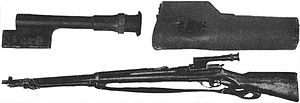Type_97_Sniper_Rifle
Type 97 sniper rifle
Sniper rifle
The Type 97 sniper rifle (九七式狙撃銃, Kyū-nana-shiki sogekijū) is a Japanese bolt-action rifle, based on the Type 38 rifle. Following the standard practice of the time, it was adapted from an existing infantry rifle. The only difference between this rifle and the original Type 38 is that it had a lightened stock, a 2.5 power telescopic sight and a mid-band setup for a monopod, although later models had this deleted. The rifle entered service in 1937. When fired, the mild 6.5x50mm Arisaka cartridge gave off little flash or smoke and made counter-sniper activity difficult. The lack of flash and smoke comes from the length of the barrel; a 794 millimetres (31.3 in) long barrel allows the cartridge propellant to fully burn and attain the optimum combination of accuracy and bullet velocity. The scope was offset to the left, to allow stripper clip loading. Like other Mauser pattern rifles, it has a five-round box magazine. The rifle can be loaded with either a 5-round stripper clip, or single rounds.
This article needs additional citations for verification. (December 2009) |
The Type 97 was manufactured at the Nagoya Arsenal and Kokura Arsenal, with approximately 14,500 produced at the Nagoya Arsenal,[4] and 8,000 at the Kokura Arsenal.[5]
